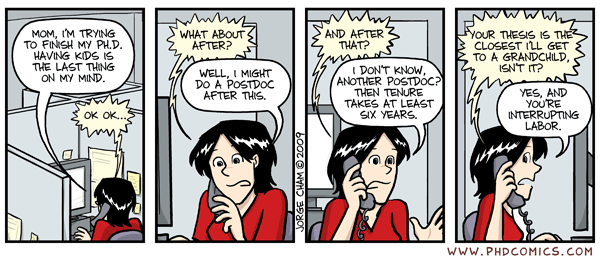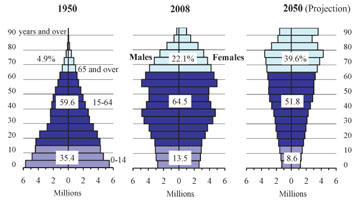DOI: 10.1145/1734454.1734479 | CITEULIKE: 6775809 | REFERENCE: BibTex, Endnote, RefMan | PDF ![]()
Bartneck, C. (2010). Create Children, Not Robots! Proceedings of the 5th ACM/IEEE International Conference on Human-Robot Interaction, Osaka pp. 75-76.
Create Children, Not Robots!
Department of Industrial Design
Eindhoven University of Technology
Den Dolech 2, 5600MB Eindhoven, NL
christoph@bartneck.de
Abstract - This essay investigates the situation of young researchers in the HRI community. I argue that we need to have a more child friendly environment to encourage young staff members to create children.
Keywords: elderly; children; academia; birth rate
Introduction
The population in developed countries is ageing. People live longer and the birth rate is dropping. The fertility rate in Japan, for example, has dropped from 3.65 in 1950 to 1.37 in 2008, which led to an effective decrease in Japans population. Figure 1 presents Japans population and the projections for 2050 are dramatic. Japan will soon have more elderly people than young. But Japan is not the only country suffering from an aging society, other developed countries share Japans fate.
Fig. 1. Changes in Japans population pyramid (source: Statistics Bureau, Japans Ministry of Health, Labor and Welfare)
One response to this dramatic development is to build robots that assist the elderly. The World Robotics Report 2008 shows that the budget for handicap assistance robots was approximately 1 million USD in 2007 and it is expected to grow to 13 million USD in the period of 2008-2011. But this is only the commercial side. Governments around the world made considerable research funds available to help building robots.
Caring for the elderly has been a frequent argument to motivate funding applications, defining resulting research questions and setting requirements for the development of robot. This is reflected in the proceedings of the HRI conference. A superficial scan of the proceedings revealed that 36 papers mention the term “elderly, 52 mention “health and 10 mention “senior. Examples of robots that are intended to care for the elderly include iCat, Gecko Systems CareBot and Paro.
Before proceedings, I have to admit that I am not a sociologist and that the observations and conclusions that follow may not be as bulletproof as I would like them to be. Still, I believe that an individual perspective in the field may at least server as a stimulation for discussions on this important topic.
The policy makers that decide on the research agendas of large funding bodies, such as the European Framework Programs or the American NSF are mainly senior researchers. I will refer to his group as the policy makers. This group includes bureaucrats, politicians, full professors and deans. No conclusive data on the composition of this group of people is available since it is to be expected that a considerable lobby work is done informally.
The parents of this generation of policy makers is currently in their last phase of their lives and the policy makers experience under what conditions their parents have to spend their last years. Elderly homes and hospitals can be depressing and the care available is directly correlated to the available financial resources. Given the statistics on the development of our ageing society, it does not take a genius to predict that the policy makers will face an even more difficult situation once they approach the end of their lives. There is a considerable danger that there will not be enough young people to care about them or pay for their pension.
This grim expectation might have a positive influence on the available funding for research in robotics for the elderly. The European Commission (EC) will invest 400 million Euros ($628 million) in European health robotics research between 2007 and 2010, representing a doubling of the previous four-year investment [1].
All that research does of course need to be carried out. Often this results in hiring junior staff, such as PhD students or PostDocs. These people are at the best age to start families and give birth to children, but many postpone their parenthood until their career prospects are established [2]. In particular women are often forced to compromise on their careers for he benefit of their families and children [3]. Women in academia have even fewer children compared to other professional women, primarily because it takes longer to achieve the job security of tenure [4]. Jorge Cham made a valuable observation about the live of young academics [5] (see figure 2).

Fig. 2: Babies (PhD Comics)
The incredible amount of stress and uncertainty that young academics have to deal with often leads to a burn out. Lackritz showed that the experience of emotional stress in academic is negatively correlated to the age of the researcher [6]. In particular young academics suffer from emotional exhaustion.
One may wonder why the academic career is setup to withhold job security for such a long time. Why put young researchers in a position in which they do not know if and where on this planet they will have their next job? Why limiting contracts to only a few years? Why putting them through a tenure track process? Why do we have an academic system that systemically takes away safety?
I came to two possible explanations, and both of them are not something we can be proud of. The first explanation is that the purpose of the uncertainty is to weed out the weak. We produce more PhD than available faculty positions and hence a fearsome competition is arranged in which only the most productive survives [7]. A recent example of the consequences of work pressure is the spiral of suicides at France Telecom [8]. While the suicide rate of 23 employees might not be statistically significant higher than the nations average, it still forced the management to offer more counseling. The second explanation is related but on a more abstract level: Taking away certainty induces fear, which in return leads to a higher performance and it allows managers to control their subordinates more easily [9].
But who then is responsible for this system? Who decides on the granting of funding and the promotion of staff? It is the generation of the policy makers! And this is where the real irony of the current situation can be found. On the one hand, young researchers are supposed to build robots for the ageing society, but on the other hand, they system in which they have to operate is setup to prevent them from having children themselves! The real solution to overcome the problems of an ageing society is not to create robots, but to have more children. This means that we have to provide an academic environment in which young researchers dare to have children. We do not even have to spend much more money. It is not necessarily the income that makes young researchers decide to delay children or to not have children at all. It is incredible uncertainty that they have to deal with. We have to offer them clear and safe career opportunities. Do not be fooled that we would loose all flexibility in offering permanent positions to junior staff. If they are ambitions or curios, they will still hunt for new challenges. But they will do it from a safe base that will allow them to plan the future of their families.
We also do not need to worry that young researchers will loose all their motivation once we take the heat off from them. Scientists are most of the time internally motivated. They pursue science because they are curious and they need the academic freedom to expand their horizon. A safe position also enables young researchers to tackle new and high-risk research areas. They can bring forward provocative ideas that might not be easily published, but that have a considerable potential. Researchers that have to fear the loss of their job will most likely play safe and only tackle established research problems. It is usually not advisable to challenge a senior scientist that will be involved in the decision if you will have a job next year. I am under the impression that to some degree the uncertainty is also used to more easily control young researchers. While guidance can also be helpful, I hope that the cynical observation that science only progresses with the death of its professors will not hold true.
One may now argue that creating such a child-friendly environment is the task of the government and not that of the universities. And indeed, the Japanese government decided to grant 26.000 Yen per month to families for each child starting in 2011 [10]. But again, financial constraints are only one of the reasons why families are hesitant to have children.
What then can universities do to help their junior stuff to start families and have children? As mentioned above, the most important factor is job security. Would you want to have your first baby when you have no idea if you have a job next year? An alternative policy could be to automatically offer becoming parents a permanent position and an increase in salary.
I have to admit that the argument in this paper is to some degree a simplification of the problem. There are additional factors that I did not discuss in full length. For example, the fact that the time people spend on their education increased, that women increasingly build their own careers, or the difficulties of coordinating dual careers with parenthood. Another important fact is that on a global level, we are not suffering from a decrease in the population. A simple way to counterbalance the ageing population would be to invite young immigrants from developing countries. I am even less qualified to argue on such a global level since I am not an expert on migration. I hope that the reader allows me to focus this discussion on the academic world in the developed countries.
In summary, I argue for creating child friendly environment for young academics that gives them the safety they need to have children. Children are the future of our society and not robots. It is ironic that the current generation of policy makers are unable or unwilling to prevent the junior researcher from making the same mistakes they did.
References
- M. Butter, A. Rensma, J. v. Boxsel, S. Kalisingh, M. Schoone, M. Leis, G. J. Gelderblom, G. Cremers, M. d. Wilt, W. Kortekaas, A. Thielmann, K. Cuhls, A. Sachinopoulou, and I. Korhonen, “Robotics for healthcare,” European Commission, DG Information Society, Tech. Rep., 2008.
- A. Kemkes-Grottenthaler, “Postponing or rejecting parenthood? results of a survey among female academic professionals,” Journal of Biosocial Science, vol. 35, no. 02, pp. 213–226, 2003.
- N. H. Wolfinger, M. A. Mason, and M. Goulden, “Problems in the pipeline: Gender, marriage, and fertility in the ivory tower,” The Journal of Higher Education, vol. 79, no. 4, pp. 388–405, 2008.
- ——, “Alone in the ivory tower: How birth events vary among fast-track professionals,” 2008.
- J. Cham, “Babies,” 10/19/2009 2009.
- J. R. Lackritz, “Exploring burnout among university faculty: incidence, performance, and demographic issues,” Teaching and Teacher Education, vol. 20, no. 7, pp. 713–729, 2004, doi: DOI: 10.1016/j.tate.2004.07.002.
- L. de Meis, A. Velloso, D. Lannes, M. S. Carmo, and C. de Meis, “The growing competition in brazilian science: rites of passage, stress and burnout,” Brazilian Journal of Medical and Biological Research, vol. 36, no. 9, pp. 1135–1141, 2003.
- BBC, “French unease at telecom suicides,” 2009.
- G. Dueck, Supramanie: Vom Pflichtmenschen zum Score man. Berlin: Springer, 2006.
- T. Kambayashi, “How japan plans to have more babies,” September 29, 2009 2009.
This is a pre-print version | last updated March 8, 2010 | All Publications
